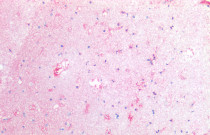ARG66229
anti-Tissue Factor antibody [HTF-1]
anti-Tissue Factor antibody [HTF-1] for Flow cytometry,Functional study,ICC/IF,IHC-Formalin-fixed paraffin-embedded sections,Western blot and Human
Overview
| Product Description | Mouse Monoclonal antibody [HTF-1] recognizes Tissue Factor |
|---|---|
| Tested Reactivity | Hu |
| Tested Application | FACS, FuncSt, ICC/IF, IHC-P, WB |
| Specificity | This antibody recognizes CD142 (tissue factor, coagulation factor III), a type I glycoprotein expressed on endothelial cells, monocytes, macrophages, and platelets upon induction by inflammatory mediators, and expressed constitutively by some tumors, the vasculature, placenta, kidney, and central nervous system. |
| Host | Mouse |
| Clonality | Monoclonal |
| Clone | HTF-1 |
| Isotype | IgG1 |
| Target Name | Tissue Factor |
| Antigen Species | Human |
| Immunogen | Human brain tissue factor (CD142). |
| Conjugation | Un-conjugated |
| Alternate Names | Thromboplastin; Tissue factor; TFA; CD142; TF; Coagulation factor III; CD antigen CD142 |
Application Instructions
| Application Suggestion |
|
||||||||||||
|---|---|---|---|---|---|---|---|---|---|---|---|---|---|
| Application Note | * The dilutions indicate recommended starting dilutions and the optimal dilutions or concentrations should be determined by the scientist. |
Properties
| Form | Liquid |
|---|---|
| Purification | Purification with Protein A. |
| Purity | > 95% (by SDS-PAGE) |
| Buffer | PBS (pH 7.4) and 15 mM Sodium azide. |
| Preservative | 15 mM Sodium azide |
| Concentration | 1 mg/ml |
| Storage Instruction | For continuous use, store undiluted antibody at 2-8°C for up to a week. For long-term storage, aliquot and store at -20°C or below. Storage in frost free freezers is not recommended. Avoid repeated freeze/thaw cycles. Suggest spin the vial prior to opening. The antibody solution should be gently mixed before use. |
| Note | For laboratory research only, not for drug, diagnostic or other use. |
Bioinformation
| Database Links | |
|---|---|
| Gene Symbol | F3 |
| Gene Full Name | coagulation factor III (thromboplastin, tissue factor) |
| Background | This gene encodes coagulation factor III which is a cell surface glycoprotein. This factor enables cells to initiate the blood coagulation cascades, and it functions as the high-affinity receptor for the coagulation factor VII. The resulting complex provides a catalytic event that is responsible for initiation of the coagulation protease cascades by specific limited proteolysis. Unlike the other cofactors of these protease cascades, which circulate as nonfunctional precursors, this factor is a potent initiator that is fully functional when expressed on cell surfaces. There are 3 distinct domains of this factor: extracellular, transmembrane, and cytoplasmic. This protein is the only one in the coagulation pathway for which a congenital deficiency has not been described. Alternate splicing results in multiple transcript variants.[provided by RefSeq, May 2010] |
| Function | Initiates blood coagulation by forming a complex with circulating factor VII or VIIa. The [TF:VIIa] complex activates factors IX or X by specific limited protolysis. TF plays a role in normal hemostasis by initiating the cell-surface assembly and propagation of the coagulation protease cascade. [UniProt] |
| Calculated MW | 33 kDa (unmodified); 45-50 kDa (glycosylated) |
Images (1) Click the Picture to Zoom In






